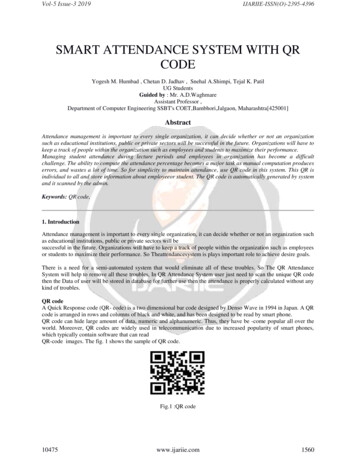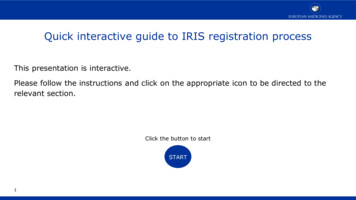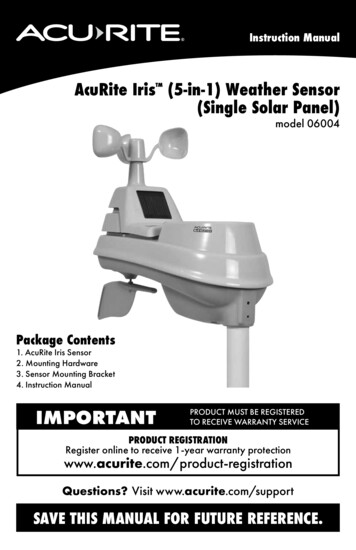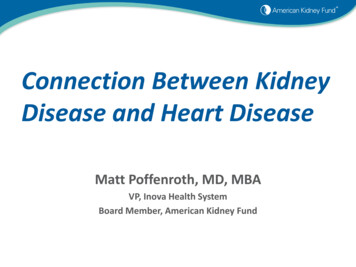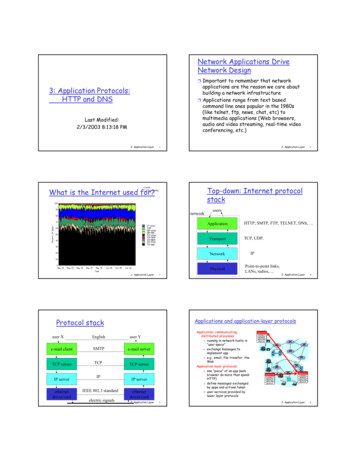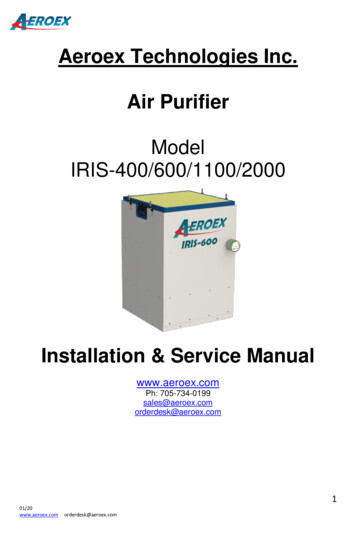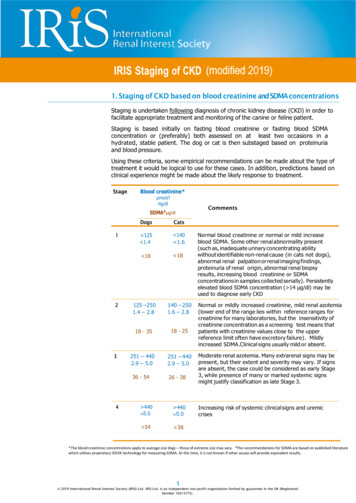
Transcription
21. Staging of CKD based on blood creatinine and SDMA concentrationsStaging is undertaken following diagnosis of chronic kidney disease (CKD) in order tofacilitate appropriate treatment and monitoring of the canine or feline patient.Staging is based initially on fasting blood creatinine or fasting blood SDMAconcentration or (preferably) both assessed on at least two occasions in ahydrated, stable patient. The dog or cat is then substaged based on proteinuriaand blood pressure.Using these criteria, some empirical recommendations can be made about the type oftreatment it would be logical to use for these cases. In addition, predictions based onclinical experience might be made about the likely response to treatment.StageBlood ats 125 1.4 140 1.6 18 18125 –2501.4 – 2.8140 – 2501.6 – 2.818 - 3518 - 25251 – 4402.9 – 5.0251 – 4402.9 – 5.036 - 54426 - 38 440 5.0 440 5.0 54 38Normal blood creatinine or normal or mild increaseblood SDMA. Some other renal abnormality present(such as, inadequate urinary concentrating abilitywithout identifiable non-renal cause (in cats not dogs),abnormal renal palpation or renal imaging findings,proteinuria of renal origin, abnormal renal biopsyresults, increasing blood creatinine or SDMAconcentrations in samples collected serially). Persistentlyelevated blood SDMA concentration ( 14 µg/dl) may beused to diagnose early CKDNormal or mildly increased creatinine, mild renal azotemia(lower end of the range lies within reference ranges forcreatinine for many laboratories, but the insensitivity ofcreatinine concentration as a screening test means thatpatients with creatinine values close to the upperreference limit often have excretory failure). Mildlyincreased SDMA.Clinical signs usually mild or absent.Moderate renal azotemia. Many extrarenal signs may bepresent, but their extent and severity may vary. If signsare absent, the case could be considered as early Stage3, while presence of many or marked systemic signsmight justify classification as late Stage 3.Increasing risk of systemic clinical signs and uremiccrises*The blood creatinine concentrations apply to average size dogs – those of extreme size may vary. #The recommendations for SDMA are based on published literaturewhich utilizes proprietary IDEXX technology for measuring SDMA. At this time, it is not known if other assays will provide equivalent results.1 2019 International Renal Interest Society (IRIS) Ltd. IRIS Ltd. is an independent non-profit organization limited by guarantee in the UK (RegisteredNumber 10213173).
IRIS Staging of CKD (modified 2019)Discrepancies between creatinine and SDMAIRIS CKD staging is based on fasting blood creatinine concentration and bloodSDMA concentration. SDMA may be a more sensitive marker that is less impactedby loss of lean body mass.DOGS:If serum or plasma SDMA is persistently 18 µg/dl in a dog whose creatinine is 1.4mg/dl (IRIS CKD stage 1 based on creatinine), this canine patient should be stagedand treated as an IRIS CKD Stage 2 patient.If serum or plasma SDMA is persistently 35 µg/dl in a dog whose creatinine isbetween 1.4 and 2.8 mg/dl (IRIS CKD stage 2 based on creatinine), this caninepatient should be staged and treated as an IRIS CKD Stage 3 patient.If serum or plasma SDMA is persistently 54 µg/dl in a dog whose creatinine isbetween 2.9 and 5.0 mg/dl (IRIS CKD stage 3 based on creatinine), this caninepatient should be staged and treated as an IRIS CKD Stage 4 patient.CATS:If serum or plasma SDMA is persistently 18 µg/dl in a cat whose creatinine is 1.6mg/dl (IRIS CKD stage 1 based on creatinine), this feline patient should be stagedand treated as an IRIS CKD Stage 2 patient.If serum or plasma SDMA is persistently 25 µg/dl in a cat whose creatinine isbetween 1.6 and 2.8 mg/dl (IRIS CKD stage 2 based on creatinine), this feline patientshould be staged and treated as an IRIS CKD Stage 3 patient.If serum or plasma SDMA is persistently 38 µg/dl in a cat whose creatinine isbetween 2.9 and 5.0 mg/dl (IRIS CKD stage 3 based on creatinine), this feline patientshould be staged and treated as an IRIS CKD Stage 4 patient.SDMA assays are offered by a number of laboratories throughout the world. Themethodology used has not yet been standardized and the recommendations madeabove are based on the proprietary methodology offered by IDEXX Laboratories.These recommendations are based on current state of knowledge where SDMAappears to be a more sensitive indicator of early stage CKD in the dog and cat. Thespecificity of SDMA has not been tested in large scale prospective studies to enable allthe factors influencing specificity to be understood. We expect these guidelines to beupdated with further recommendations that will assist the use of SDMA in thediagnosis and staging of CKD in the future.2 2019 International Renal Interest Society (IRIS) Ltd. IRIS Ltd. is an independent non-profit organization limited by guarantee in the UK (RegisteredNumber 10213173).
IRIS Staging of CKD (modified 2019)2a. Substaging by ProteinuriaThe goal is to identify renal proteinuria having ruled out post-renal andpre-renal causes.Standard urine dipsticks can give rise to false positives therefore practitioners shouldconsider using a more specific screening test such as the urine protein to creatinineratio (UP/C) of a species-specific albuminuria assay.The UP/C should be measured in all dogs and cats with CKD, provided there is noevidence of urinary tract inflammation or hemorrhage and the routine measurementof plasma proteins has ruled out dysproteinemias. Ideally substaging should be doneon the basis of at least two urine samples collected over a period of at least 2 weeks.SubstageUP/C valueDogsCats 0.2 0.20.2 to 0.50.2 to 0.4 0.5 0.4Non-proteinuricBorderline proteinuricProteinuricCanine and feline patients that are persistently borderline proteinuric should be reevaluated within 2 months and re-classified as appropriate.UP/Cs in the non-proteinuric or borderline proteinuric range may be categorized as‘microalbuminuric’. The significance of microalbuminuria in predicting future renalhealth is not completely understood at present. IRIS’ recommendation is to continue tomonitor this level of proteinuria (dogs). Veterinarians might offer treatment for catspersistently in the borderline proteinuric or microalbuminuric range considering theassociation with proteinuria of this level and progressive kidney disease in the cat (seetreatment guidelines).Proteinuria may decline as renal dysfunction worsens and so may be less frequentin dogs and cats in Stages 3 and 4.Response to any treatment given to reduce glomerular hypertension, filtrationpressure, and proteinuria, should be monitored at intervals using UP/C.3 2019 International Renal Interest Society (IRIS) Ltd. IRIS Ltd. is an independent non-profit organization limited by guarantee in the UK (RegisteredNumber 10213173).
2b. Substaging by Arterial Blood PressureIRIS Staging of CKD (modified 2019)2b. Substaging by Blood pressureCanine and feline patients should be acclimatized to the measurement conditionsand multiple measurements taken. The final classification should rely upon multiplesystolic blood pressure determinations, preferably done during repeated patientvisits to the clinic on separate days, but acceptable if during the same visit with atleast 2 hours separating determinations. Patients are substaged by systolic bloodpressure according to the degree of risk of target organ damage, and whether thereis evidence of target organ damage or complications.For most dogs and all cats, the IRIS blood pressure substages are as follows:Systolic Blood Pressuremm HgBlood PressureSubstageRisk of Future TargetOrgan Damage 140NormotensiveMinimal140 – 159LowPrehypertensive160 – 179Hypertensive 180ModerateSeverely hypertensiveHighHowever, some breeds of dog, particularly sight hounds, tend to have higher bloodpressure than other breeds. It is preferable to use breed-specific reference ranges ifavailable. The classification of risk of future target organ damage in “high-pressurebreeds” might be adjusted as follows:Minimal risk – systolic pressure 10 mm Hg above the breed-specificreference rangeLow risk – systolic pressure 10-20 mm Hg above the breed-specific reference rangeModerate risk – systolic pressure 20-40 mm Hg above the breed-specificreference rangeHigh risk – systolic pressure 40 mm Hg above the breed-specific reference range.As with proteinuria, in the absence of evidence of existing target organ damage,demonstration of persistence of blood pressure readings within a particularcategory is important. ‘Persistence’ of increase here should be judged on multiplemeasurements made over the following timescales in these blood pressuresubstages:Hypertensive – systolic blood pressure 160 to 179 mm Hg measuredover 1 to 2 weeksSeverely hypertensive – systolic blood pressure 180 mm Hg measured over 1 to2 weeks.4 2019 International Renal Interest Society (IRIS) Ltd. IRIS Ltd. is an independent non-profit organization limited by guarantee in the UK (RegisteredNumber 10213173).
2b. Substaging by Arterial Blood PressureIRIS Staging of CKD (modified 2019)3. Revision of staging and substaging after treatmentThe stage and substages assigned to the patient should be revised appropriately aschanges occur. For example, a substantial increase in blood creatinine or SDMAconcentration might warrant reassignment to a higher stage to reflect the newsituation.Similarly, if antihypertensive (or antiproteinuric) treatment has been instituted, thepatient’s classification on re-evaluation should be adjusted if necessary to reflect thenew blood pressure (or UP/C) rather than the original status, with the addition of anindication that the current classification is affected by treatment.The following two examples illustrate the process of revision, where ‘treating’is used as an indicator of ongoing treatment.Example 1Euvolemic cat with stable renal functionCreatinine 200 µmol/l (2.3 mg/dl)SDMA 22 µg/dlUP/C 0.32Systolic blood pressure 200 mm HgClassification – IRIS CKD Stage 2, borderline proteinuric, severely hypertensive.Same cat after antihypertensive treatmentCreatinine 220 µmol/l (2.5 mg/dl)SDMA 24 µg/dlUP/C 0.12Systolic blood pressure 155 mm HgNew classification – IRIS CKD Stage 2, non-proteinuric, prehypertensive (treating).Example 2Euvolemic dog with stable renal functionCreatinine 230 µmol/l (2.6 mg/dl)SDMA 39 µg/dlUP/C 0.8Systolic blood pressure 155 mm HgClassification – IRIS CKD Stage 3,, proteinuric, prehypertensiveNote: As described above in the Discrepancies between creatinine and SDMA section,if blood SDMA is persistently 35 µg/dl in a canine patient whose blood creatinine is between1.4 and 2.8 mg/dl (IRIS CKD stage 2 based on creatinine), this dog should be staged andtreated as an IRIS CKD Stage 3 patientSame dog after antiproteinuric treatmentCreatinine 240 µmol/l (2.7 mg/dl)SDMA 42 µg/dlUP/C 0.4Systolic blood pressure 155 mm HgNew classification – IRIS CKD Stage 3, borderline proteinuric (treating),prehypertensive.
Low risk - systolic pressure 10-20 mm Hg above the breed-specific reference range Moderate risk - systolic pressure 20-40 mm Hg above the breed-specific reference range High risk - systolic pressure 40 mm Hg above the breed-specific reference range. As with proteinuria, in the absence of evidence of existing target organ damage, .


